

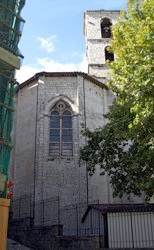
Franciscans in Trevi
St Francis visited Trevi just after its sack by Spoleto, and tradition has it that he established a Franciscan community here. However, the first documented reference to such a community dates to 1285, when Pope Honorius IV empowered the guardian of the convent to absolve the people of Trevi from excommunication. (They had been excommunicated for helping Perugia in its war against Foligno).
Santa Maria (ca. 1268)
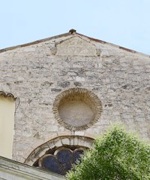
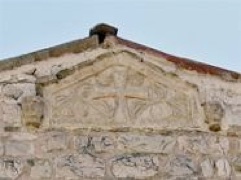
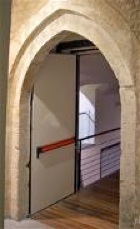
The sculpted tympanum, the rose window and two reliefs to the sides (of a king or emperor and a pope) were removed from their original locations at this time and embedded in the tympanum of the later church (illustrated above). Plaster casts of the tympanum and the reliefs are exhibited in the Museo della Città e del Territorio.
The inscription along the lower end of the tympanum records that Master Angelo built the church (or at least its facade) in 1268:
MAG(iste)R ANGELO FECIT HOC OP(us)
AN(n)O D(omi)NI MCCLXVIII M(en)SE MAII
AVE MARIA GRA(tia plena) DOMIN(us) TECU(m) B(e)N(e)D(i)CTA TU
In 1291, Pope Nicholas IV granted indulgences to those visiting the church on certain feast days, presumably to help with the financing of its extension and decoration. The Blessed Ventura was buried here in 1310 and the church was re-dedicated in his honour at that time. His remains were housed in a Roman sarcophagus that was probably under the high altar.
San Francesco
Work began on the present church in 1354. It was sponsored by the Commune, because the new church was of civic as well as ecclesiastical importance: when public assemblies could not be held in the piazza because of bad weather, they were held in the church. The Commune ordered local peasants to provide the wood needed to make the limestone, and the inhabitants of the Matigge area who owned animals for transport were required to use them to bring stone from the quarry of Colle di Paterno.
The earlier church, which was now the lower church, served as a cemetery and housed the graves that had their memorial slabs in the pavement of the new church above.
The relics of the Blessed Ventura and their sarcophagus were translated to the high altar of the new church, probably as soon as it was ready to receive them. The church was re-dedicated as San Francesco in 1477 and the relics of the Blessed Ventura remained largely forgotten until they were re-discovered in 1593 (see below).
The community was suppressed in 1810 during the Napoleonic occupation. An inscription records it transfer, in 1859, to the Confraternita di San Giuseppe, a charitable organisation that had been founded by Don Ludovico Pieri (see below). It was restored in 1910, but the Commune requisitioned it in 1922 and it was used to store grain. It was restored again in 1970 and re-opened as a church in 1985. It is now de-consecrated and forms part of the museum complex of Trevi.
Inscription (ca. 100 AD)
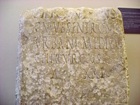
Exterior
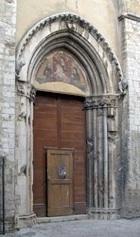
Madonna and Child with saints (ca. 1400)
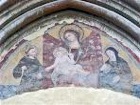
Interior
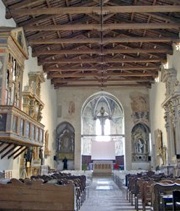
The church has a single nave, a polygonal central apse and two flanking apsidal chapels. The original high altar was demolished in 1593 and rebuilt against the wall of the apse. The relics of the Blessed Ventura in their Roman sarcophagus, which had been largely forgotten, were re-discovered at this point:
-
✴the relics were translated to the right apsidal chapel; and
-
✴the sarcophagus was moved to the counter-facade (see below).
Eight side altars were then built in the period to 1630. A number of the original frescoes (see below) were recovered in a restoration in 1910, when four of these side altars were demolished.
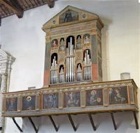
Left Wall
Madonna and Child with saints (1577)
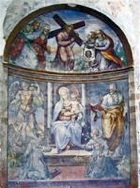
-
✴The main scene depicts the Madonna and Child enthroned with the Archangel Gabriel and SS Francis, Antony of Padua and Joseph.
-
✴The scene in the lunette depicts Christ carrying the cross, with the Virgin, St Veronica and other women.
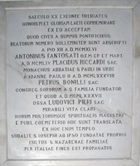
-
✴Don Ludovico is buried in the pavement here.
-
✴The marble plaque nearby commemorates the Blessed Peter Bonilli and two other men from Trevi (described in the page on saints of Trevi) who were beatified or canonised in the 20th century:
-
•Blessed Placid Riccardi and
-
•St Antony Fantosati.
Altare della Crocefissione (1597)
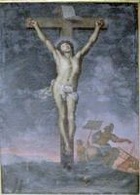
Altare delle Stimate di San Francesco (late 16th century)
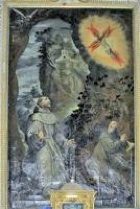
Cappella di Sant’ Antonio da Padova
This chapel to the left of the apse belonged to the Valenti family. It was modified in the 16th century, when the present altar was built.

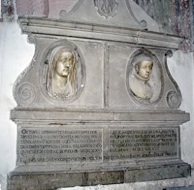
Monument to Monument to Ottavia Attavanti
Giacomo Valenti and Alessandro Valenti
The chapel contains two Valenti tombs:
-
✴The aedicule on the back wall contains the inscription from the monument to Giacomo Valenti (died 1357). It originally contained the painted stone monument now on the right wall.
-
✴The monument (1576-7) to Alessandro Valenti and his mother, Ottavia Attavanti is on the left.
Frescoes (ca. 1372)
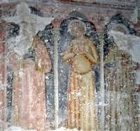
-
✴Pope Urban V holding an image of SS Peter and Paul;
-
✴St Catherine of Alexandria; and
-
✴St Antony of Padua.
They probably date to the time of the death of Pope Urban V.
Apse
Christus Patiens (early 14th century)
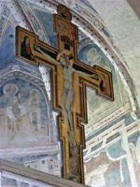
The image depicts the suffering Christ on the cross, with
-
✴the Risen Christ and two angels above;
-
✴half-length figures of the Virgin and St John the Evangelist to the sides; and
-
✴St Francis below, kissing the feet of Christ, kneeling on a buried skull.
Scenes from the life of the Virgin (14th century)
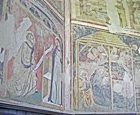
Right Apsidal Chapel
This chapel belonged to the Petroni family in the 16th century. When the relics of the Blessed Ventura were rediscovered under the high altar in 1593, Muzio Petroni arranged for their solemn translation to the back wall of this chapel. A copy of the account that he wrote of the life of the Blessed Ventura was enclosed in the new sarcophagus. (The original sarcophagus in which the relics had been housed since 1310 is now on the counter-façade – see below).
Frescoes (14th century)
These frescoes on the left wall include images of:
-
✴St Emilianus (above); and
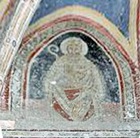
-
✴Blessed Ventura and SS Nicholas of Bari and Andrew.
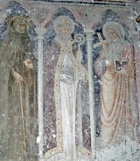
Frescoes above the entrance (14th century)
These frescoes depict:
-
✴the stigmatisation of St Francis (above); and
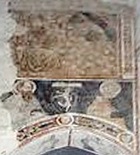
-
✴SS Peter and Paul.
Right Wall
St Antony Abbot (15th century)
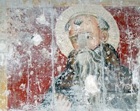
Altare della Madonna della Neve (1620)
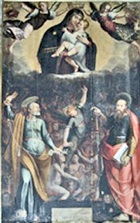
Madonna and Child with St Peter Martyr (15th century)
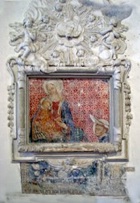
"HOC OPUS FECIT FIERI LUCAS LUCARELLI MCCCC ..."
Lucas Lucarelli commissioned this work in 14 ...
Altare del Spirito Santo (1613)
An inscription records that Filippo Palazzi, “PHILOSOPHUS ARTIS MEDICINAE DOCTOR” commissioned this altar (the 1st on the right), which was completed (presumably after his death, by his brother Ascanio in 1613. An inscription on the damaged altarpiece (ca. 1613), which depicts the descent of the Holy Spirit at Pentecost, also commemorates Filippo Palazzi. This altarpiece is attributed to Simeone Ciburri.
Scenes from the life of St Onuphrius (ca. 1400)
These ruined frescoes, which are attributed to the Maestro dell’ Abside Destra di San Francesco di Montefalco, are on the right wall (near the counter-facade).
Counter-façade
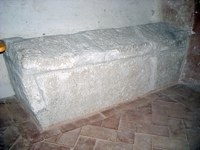
The sarcophagus (4th century) that was re-used in 1310 for the burial of the Blessed Ventura under the high altar was moved here in 1523 (when the relics were moved to the right apsidal chapel).
St Michael (ca. 1400)
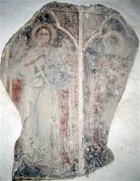
Art from the Church
Panels from a Polyptych (ca. 1430)
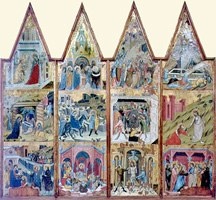
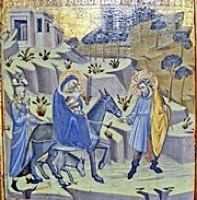
Detail: Flight into Egypt
These four panels, which are attributed to Giovanni di Corraduccio Mazzaforte, came from San Francesco. They depict scenes from the life of Christ. A number of scenes (eg. the Crucifixion) are missing, suggesting that there was originally a fifth, central panel. The surviving panels were moved to the Pinacoteca in 1867.
Convent
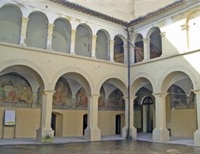
The adjoining convent was rebuilt in 1640-50 but closed in 1810.
Cardinal Emmanuele de Gregorio acquired the buildings in 1833. He commissioned Giuseppe Valadier to adapt it for use by the Collegio Lucarini, which was moved here from Palazzo Lucarini, via Palazzo dei Valenti di Riosecco, after the earthquake of 1832. The college, which passed in 1863 to the Salesians, closed in 1963
The convent was restored in the 1990s and now houses the museum complex of Trevi.
Scenes from the life of St Francis (1645)
These frescoes in the lunettes around the central cloister are by Bernardino Gagliardi. Inscriptions below commemorate the noble families that paid for them. Some of the scenes have disappeared, others were repainted in the 18th century, and some were restored in 2001.

